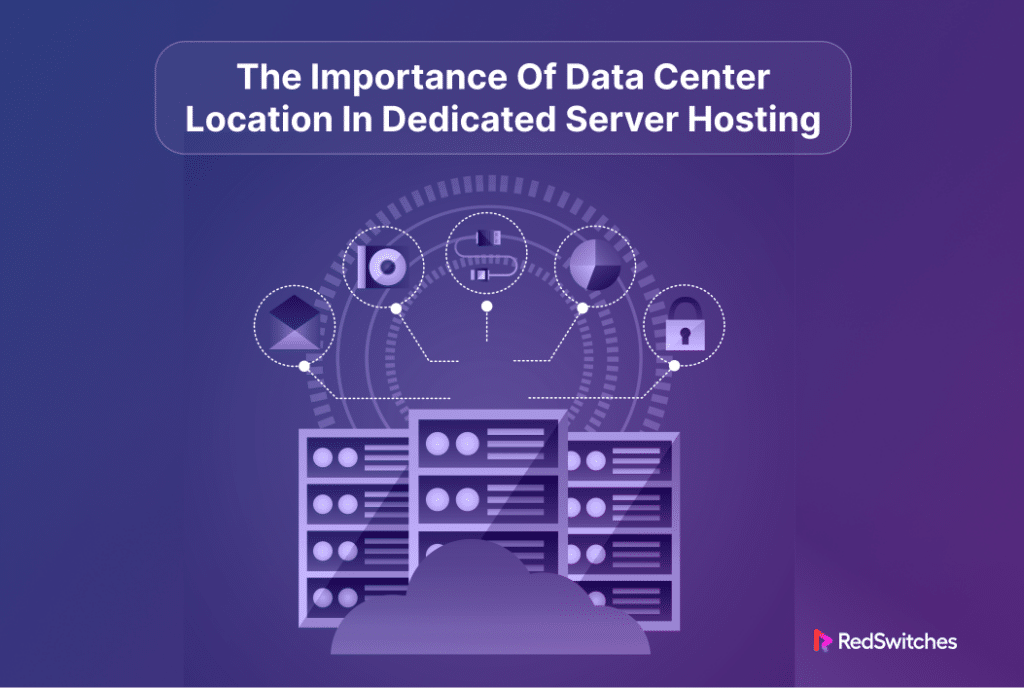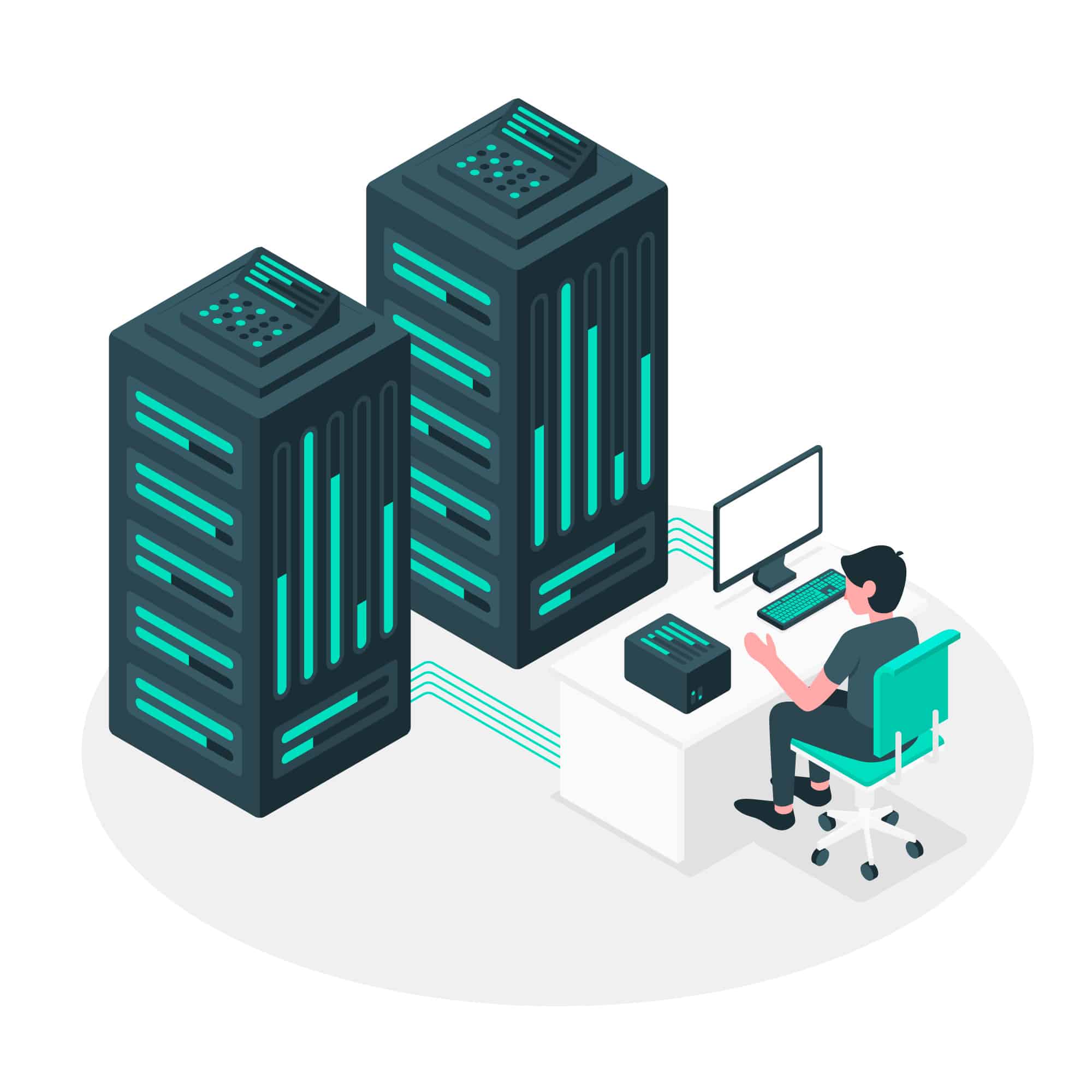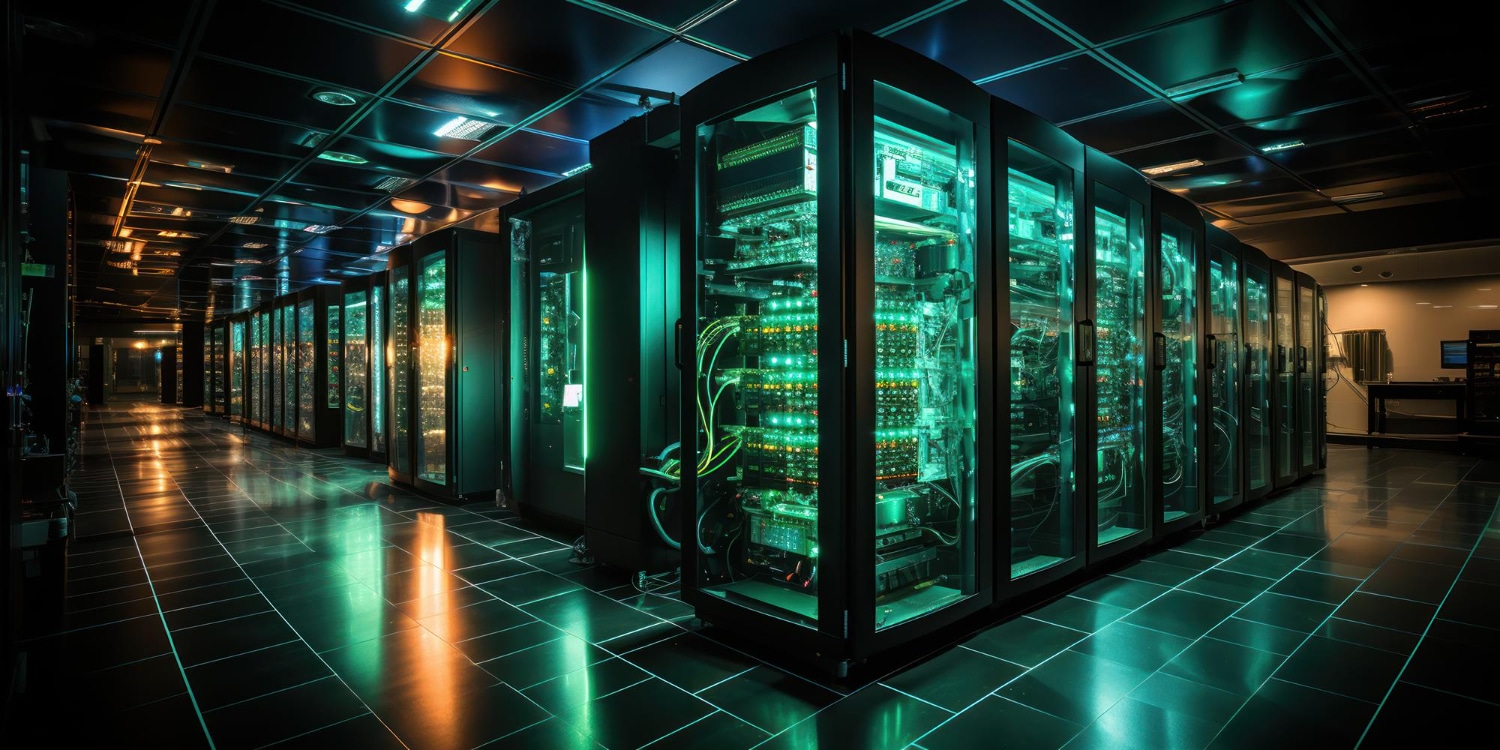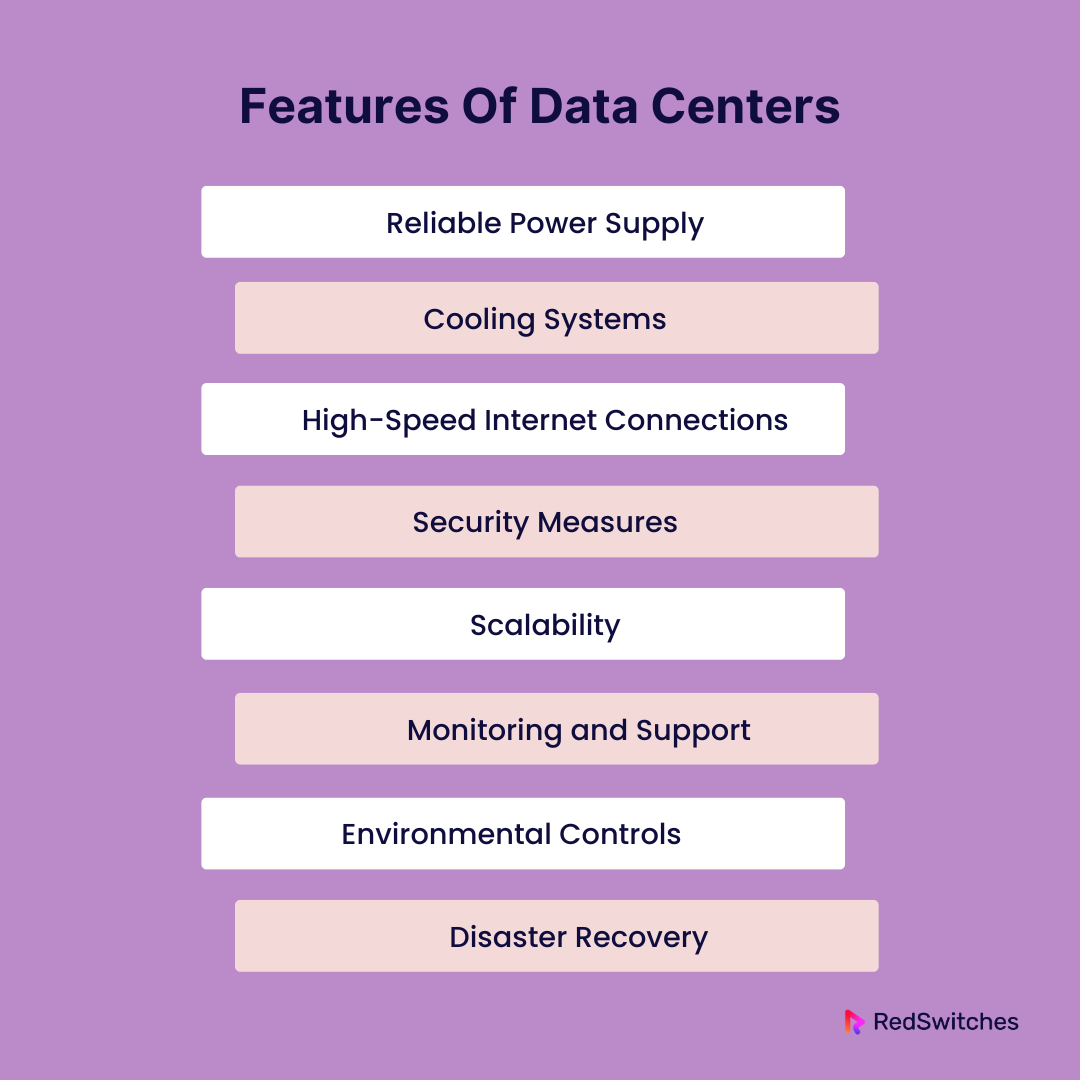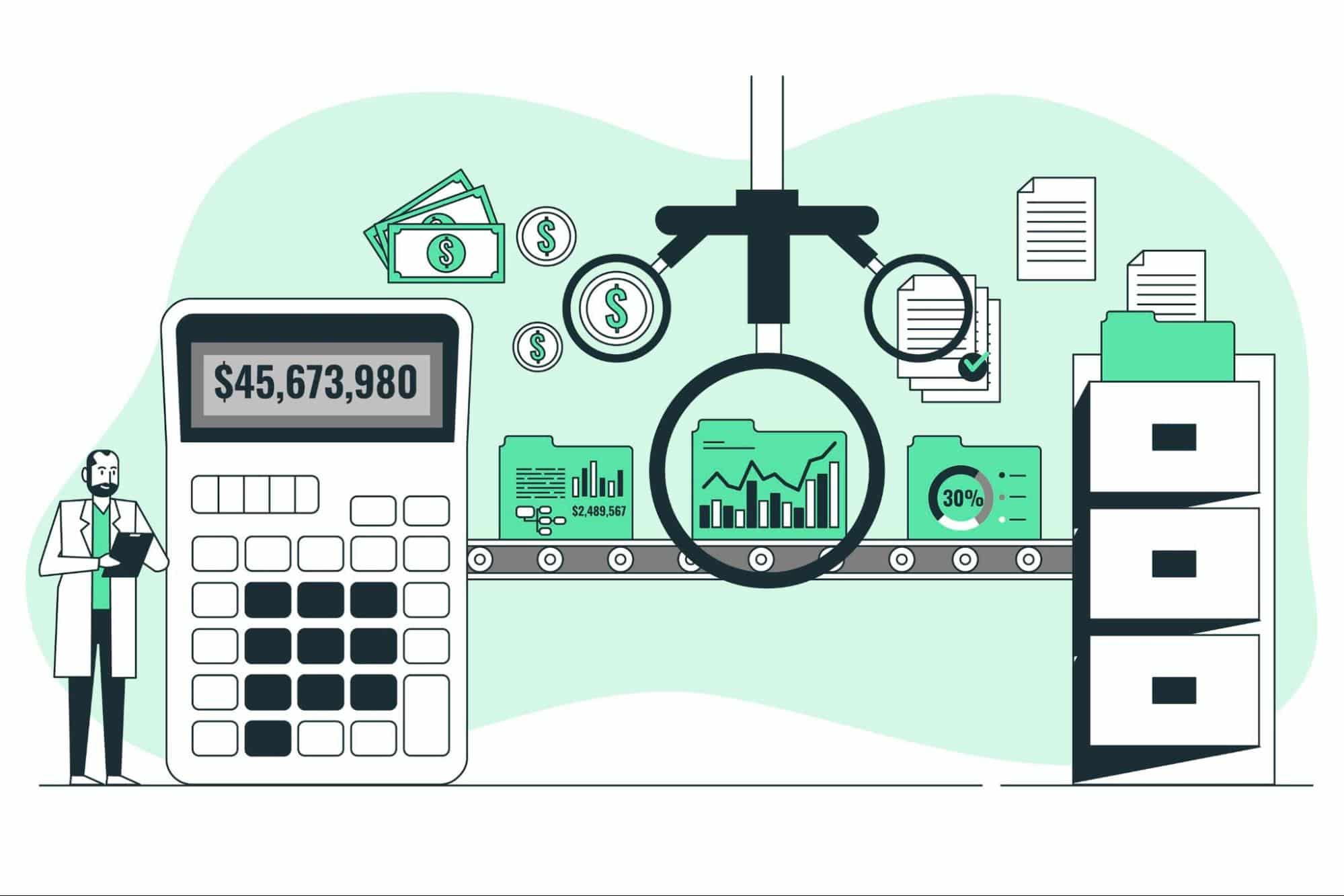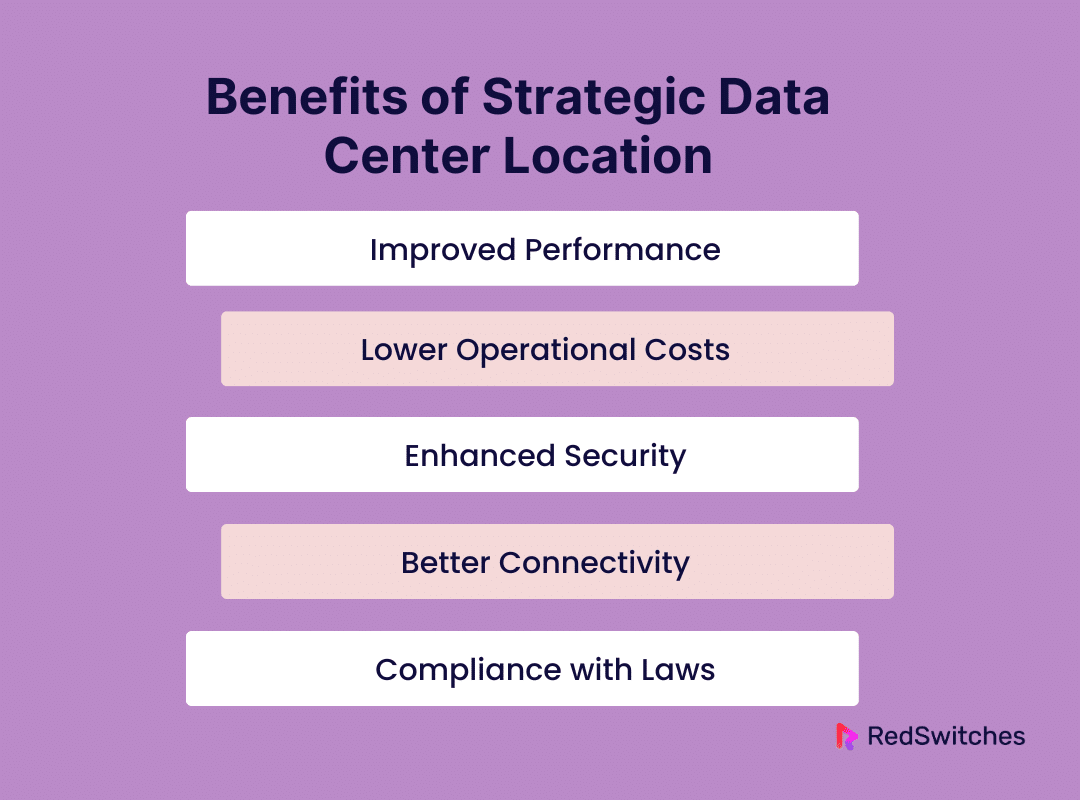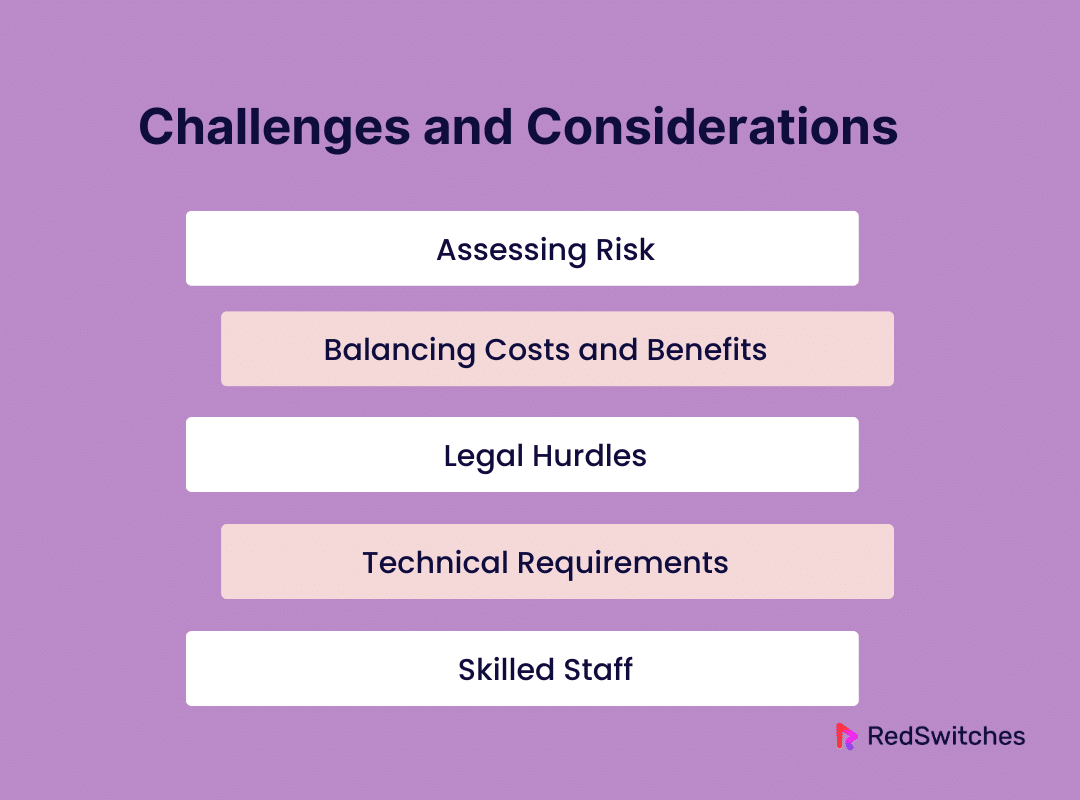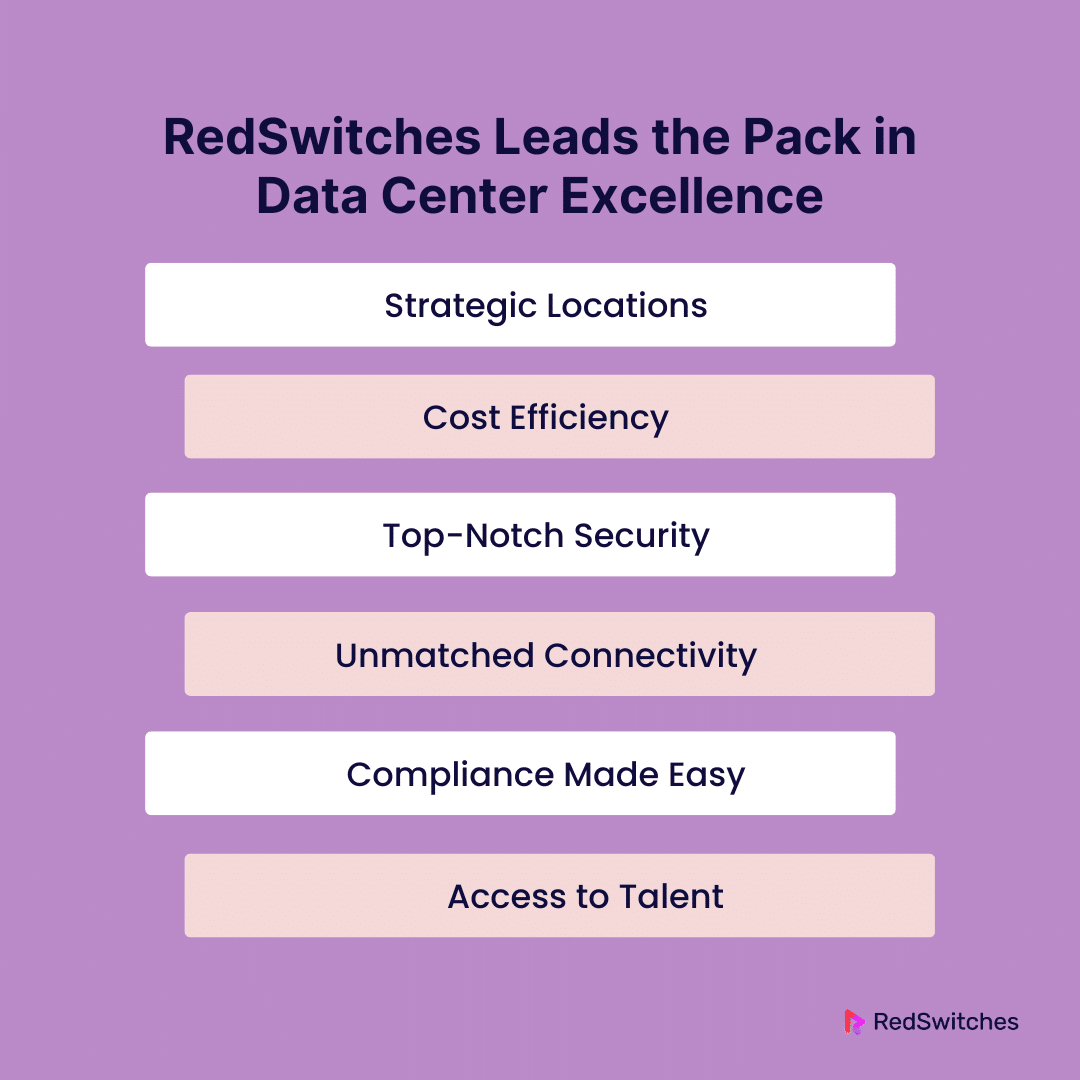Key Takeaways
- Data center location is crucial for speed, security, and reliability in dedicated server hosting.
- Dedicated hosted servers offer exclusive resources for hosting, custom configuration, providing optimal performance and control.
- Strategic data center locations ensure lower latency for faster access to data and applications.
- Choosing a data center in a geographically stable area minimizes risk from natural disasters.
- Legal and regulatory compliance is essential, with data sovereignty laws impacting data center operations.
- Network reliability and connectivity depend on high-quality equipment and multiple ISP connections.
- The data center’s location can significantly influence operational costs, affecting energy and staffing expenses.
- Physical security measures protect data centers from unauthorized access and environmental threats.
- Environmental controls within data centers safeguard hardware and ensure optimal server performance.
- RedSwitches excels by strategically locating their data centers for optimal performance, security, and cost-efficiency.
Choosing the right location for a data center is crucial in dedicated private server hosting. This decision impacts the speed at which data travels and how safe and reliable that data is. A well-placed data center ensures faster access to websites and applications for users. It also means better protection against natural disasters.
A report by Statista shows that the revenue in the Data Center market is projected to reach US$340.20bn in 2024. This highlights the increasing demand for data centers that are both efficient and strategically located.
The data center’s location in server hosting can affect everything from speed to security. Making the right choice for businesses can lead to improved performance and satisfied customers. This article will explore why location is important and what factors to consider when choosing a data center location in dedicated server hosting.
Table of Contents
- Key Takeaways
- What Are Dedicated Servers?
- How Do Dedicated Private Servers Work?
- What Are Data Centers?
- Features Of Data Centers
- The Importance of Dedicated Server Data Center Location
- Benefits of Strategic Data Center Location
- Challenges and Considerations
- RedSwitches Leads the Pack in Data Center Excellence
- Conclusion
- FAQs
What Are Dedicated Servers?
Credits: Freepik
Dedicated hosted servers are powerful computers used exclusively by one client or company. They host websites, applications, and data. Unlike shared servers, they don’t split their resources among multiple users. This setup gives one user all the power and control.
Where Are Servers Stored?
Servers are kept in data centers. These places are built to house servers safely. They have strong internet connections, power backups, and security measures. This environment keeps servers online and secure around the clock.
Also Read: What Is Dedicated Server and How Does It Work?
How Do Dedicated Private Servers Work?
When you use a dedicated server, it’s like having your personal computer on the internet. But this one is much stronger and always on. Here’s how it works:
Connection and Speed
Your dedicated virtual server connects to the internet at high speeds. This lets your website or app load quickly for anyone who visits. Fast loading is crucial for keeping users happy.
Resources Just for You
Since the server is all yours, its resources are, too. This means the server’s memory, storage, and processing power are just for you. You don’t share them with others. This setup ensures your site or app runs smoothly, even when many people visit simultaneously.
Security and Control
With a server, you get full control. You can choose the software and settings that best fit your needs. This freedom lets you optimize performance and security. Speaking of security, having your server means you’re not at risk from other users’ potential security issues.
Maintenance and Support
While you have control, you’re not alone. Most dedicated managed server providers offer maintenance and support. They handle hardware issues, software updates, and other technical needs. This support helps keep your server running well.
Also Read, Understanding Dedicated Server Hardware: A Beginner’s Guide in 2024
What Are Data Centers?
Credits: Freepik
Data centers are special buildings that hold servers and other computing hardware. They are the internet’s heart, storing, managing, and distributing data. These centers ensure websites, apps, and private cloud services work round the clock.
Features Of Data Centers
Let’s discuss some of the features of data centers.
Reliable Power Supply
A constant computing power supply is vital. Data centers use a mix of the main power, backup generators, and batteries. This setup keeps servers running, even during a power cut.
Cooling Systems
Servers work hard and get hot. Cooling systems keep them at the right temperature. This prevents overheating and ensures everything runs smoothly.
High-Speed Internet Connections
Data centers connect to the Internet at high speed. This allows quick data transfer. Fast connections help websites and apps to load quickly for users everywhere.
Security Measures
Security is a top priority. Data centers have physical and digital security measures. Guards, cameras, and secure entry points protect the hardware. Firewalls and encryption protect data from hackers.
Scalability
As businesses grow, they need more space and power. Data centers offer this flexibility. Companies can add more servers or upgrade existing ones without hassle.
Monitoring and Support
Experts monitor data centers 24/7. They watch for issues and fix them fast. This constant vigilance keeps services running without interruption.
Environmental Controls
Besides cooling, data centers control humidity and dust. These controls protect the servers and ensure they work in the best conditions.
Data centers plan for the worst. They back up data and have recovery plans ready. This preparation means that even after a disaster, data can be restored.
Data centers are more than just buildings. They are the foundation of our digital world. They ensure that our online experiences are fast, reliable, and secure.
Also Read: The Key Advantages of Dedicated Server Hosting for Businesses in 2024
The Importance of Dedicated Server Data Center Location
Choosing the right location for a data center that hosts dedicated exclusive servers. This choice affects how well and how fast data travels. It also impacts the safety and reliability of the data stored. A good location means quicker access to websites and apps for users. It also means less risk from natural disasters. Plus, it can help with following local laws about data. In short, where a data center sits plays a big part in the online experience for everyone. It’s key to ensuring data is secure, quickly accessible, and properly managed.
Latency: The Speed of Data
Latency is a term that measures how long it takes for data to travel from one point to another. In the world of dedicated servers and data centers. Low latency means data moves quickly. High latency means slower data transfer. Let’s dive deeper into this concept.
How Latency Affects Performance
You want it fast when you click a link or load a website. Latency determines this speed. Lower latency results in a better user experience. It’s like the difference between a quick chat and a delayed response. For websites and online services, quick is always better.
The Journey of Data
Data travels through cables, like fiber optics, to reach its destination. The distance between a data center and its users can make this journey short or long. A data center close to its users has lower latency. This is because data has less distance to travel.
The Role of Internet Backbones
Internet backbones are the highways of the Internet. They connect different networks. Data centers close to these backbones have an advantage. Their data has a direct route. This setup reduces the number of stops data makes, lowering latency.
Physical and Digital Paths
The physical path of data is one thing. The digital route is another. Data travels through various networks and devices. Each stop can add delay. Optimized network paths reduce these stops. They ensure data takes the quickest route possible.
Why Latency Matters
Every millisecond counts in online gaming, stock trading, or video streaming. High latency can ruin experiences and lead to losses. For businesses, it can mean unhappy customers. That’s why choosing a data center with low latency is key. It supports fast, efficient, and satisfying online interactions.
Understanding latency helps in making informed decisions about data center locations. It’s not just about being online. It’s about being online with speed and efficiency.
Also Read, Troubleshooting Latency Challenges in Servers.
Performance
Credits: Freepik
In the world of servers with dedicated resources, performance is king. This term covers how fast and efficiently a server processes tasks and serves data to users. Several factors influence performance, including hardware specs, network setup, and data center operations.
Hardware Power
The heart of server performance lies in its hardware. High-quality CPUs, ample RAM, and fast storage solutions like SSDs ensure quick data processing and retrieval. The better the hardware, the higher the performance.
Also Read: Understanding Dedicated Server Hardware: A Beginner’s Guide in 2024
Network Speed
A server’s connection to the internet must be fast and stable. Data centers with high-speed internet connections and low congestion levels provide the bandwidth servers need to deliver content quickly to end users.
Optimized Software
Software on a server needs to be lean and optimized. This means using the latest, most efficient versions of operating systems and applications. Proper configuration reduces resource waste, boosting performance.
Data Center Efficiency
The operations of the data center itself also play a role. This includes cooling systems that keep the hardware at optimal temperatures and power supplies that ensure uninterrupted operation. Efficient data centers reduce the risk of performance throttling due to hardware overheating or power issues.
Performance is not just about speed; it’s about delivering a seamless, efficient service to users. In a high-performance dedicated storage server environment, every millisecond counts, and optimizing each aspect of the server’s operation can significantly improve user experience.
Disaster Risk
The risk of natural or human-made disasters is a critical consideration in the location of data centers. These events can interrupt services and cause data loss, making disaster risk management essential for dedicated hosted servers.
Geographic Stability
Choosing locations with low risk of earthquakes, floods, hurricanes, and other natural disasters is key. Data centers often sit in areas known for geographic and climatic stability to minimize these risks.
Infrastructure Resilience
Data centers are built to withstand disasters. This means strong buildings, backup power supplies, and emergency plans. These measures ensure servers keep running, even when things go wrong outside.
Data Backup and Recovery
Effective disaster risk management includes regular data backups and clear recovery plans. This ensures that data can be restored even in a worst-case scenario, and services can resume quickly.
Legal and Regulatory Compliance
Credits: Freepik
Legal and regulatory requirements significantly impact data center operations. These laws vary by country and region, affecting how data is stored, protected, and transferred.
Data Protection Laws
Countries have laws to protect personal data. Data centers must comply with these regulations, which might dictate encryption standards, data access policies, and user privacy protections.
International Data Transfer
Laws also govern how data crosses borders. Data centers must navigate these rules to legally transfer data between countries, especially in regions with strict data sovereignty requirements.
Compliance Certifications
Many data centers seek certifications like ISO/IEC 27001 or SOC 2. These standards prove the data center meets high security and operational excellence levels, helping clients trust their compliance posture.
Navigating disaster risks and legal landscapes is crucial for data centers hosting dedicated server solutions. These factors ensure operational continuity, protect data integrity, and comply with the complex web of global regulations.
Network Reliability and Connectivity
Network reliability and connectivity are pillars of a data center’s ability to serve dedicated hosted servers efficiently. These aspects determine how well and consistently data flows between the server and its end-users.
High-Quality Networking Equipment
Data centers rely on top-notch networking gear. This includes routers, switches, and firewalls that manage data traffic efficiently. High-quality equipment reduces the risk of bottlenecks and outages, ensuring smooth data flow.
Multiple Internet Service Providers (ISPs)
To guarantee connectivity, data centers connect to several ISPs. This redundancy means if one connection fails, another can take over without interrupting service. It’s a key part of keeping servers online all the time.
Peering Arrangements
Data centers also form peering agreements with other networks. These agreements allow direct traffic exchange between networks, reducing the hops data must be made. This leads to faster and more reliable connections.
Regular Maintenance and Monitoring
Ongoing maintenance and real-time network health monitoring are essential. Data centers watch their networks closely, ready to fix issues before they affect users. This proactive approach keeps the network reliable.
In summary, network reliability and connectivity are critical for data centers. They ensure servers can serve users effectively without interruption. Through careful planning and investment in infrastructure, data centers maintain the high level of performance users expect.
Operational Costs
Credits: Freepik
Operational costs are significant in running and maintaining dedicated hosted servers and data centers. These costs encompass everything from energy consumption to staffing, impacting the bottom line.
Energy Efficiency
Energy is one of the largest expenses for data centers. Servers, cooling systems, and backup power supplies consume a lot of electricity. Thus, energy efficiency is crucial. Modern data centers invest in efficient cooling technologies and energy-efficient hardware to reduce costs. Renewable energy sources, such as solar or wind power, are also increasingly used to mitigate expenses and environmental impact.
Location Impact
The location of a data center directly influences operational costs. Areas with lower electricity rates, cooler climates (which reduce cooling costs), and tax incentives are more cost-effective. Choosing a strategic location can significantly lower operational expenses.
Staffing and Maintenance
Skilled staff are needed to operate and maintain data centers. Salaries, training, and benefits contribute to operational costs. Automating routine tasks and investing in reliable, easy-to-maintain equipment can help manage these expenses.
Scalability and Flexibility
Operational efficiency also hinges on a data center’s ability to scale resources based on demand. Flexible infrastructure that can be easily upgraded or downsized helps optimize costs over time, avoiding overspending on unused capacity or scrambling to add resources when demand spikes.
Managing operational costs requires a multi-faceted approach. Data centers hosting dedicated private servers must balance investment in technology and staff with the need to remain efficient and competitive. Through strategic planning and continuous improvement, they can control these costs while maintaining high levels of service and reliability.
Physical Security
Physical security is a cornerstone of data center operations, especially for those hosting dedicated servers. It encompasses all measures to protect the facility, its hardware, and the data it stores from unauthorized access or physical damage.
Access Control
Data centers implement strict access control systems to ensure only authorized personnel can enter the facility. This often includes security badges, biometric scanners (like fingerprint or retinal scans), and manned security checkpoints. These layers of security ensure that only those with explicit permission can access sensitive areas.
Surveillance Systems
Around-the-clock surveillance cameras monitor all activity within and around the data center. This visual monitoring helps deter unauthorized access and provides a record of activity for security audits. Advanced systems may also include motion detectors and intrusion detection systems to alert security personnel of unauthorized access attempts.
Environmental Protections
Beyond human threats, data centers must guard against environmental risks like fires, floods, and extreme weather. Fire suppression systems, waterproofing measures, and robust construction standards protect the facility and its critical infrastructure. These protections ensure that servers remain operational and data stays safe, even in adverse conditions.
Redundancy and Backup
Physical security also involves planning for the unexpected. Data centers employ redundant power supplies, backup generators, and multiple network connections to maintain operations during power outages or network failures. These redundancies ensure that even if one system fails, another can take over without interrupting service.
In essence, physical security in data centers is about more than locks and cameras. It’s a comprehensive approach that protects against a wide range of threats, ensuring the safety and integrity of the servers and the crucial data they hold.
Data Sovereignty
Data sovereignty refers to the concept that digital data is subject to the laws and governance structures of the country in which it is stored. This principle has significant implications for businesses and data centers, especially in an era where data crosses borders within milliseconds.
The Role of Location
The physical location of data centers becomes crucial under data sovereignty laws. Storing data in a country means adhering to its privacy, access, and control regulations. Businesses must choose data center locations that align with their compliance needs and the legal requirements of their customers’ data.
Compliance Challenges
Complying with data sovereignty laws can be complex, given the various regulations across different countries. For instance, the European Union’s General Data Protection Regulation (GDPR) imposes strict rules on data handling and protection, affecting any business dealing with EU citizens’ data, regardless of where the company is based.
Strategic Data Management
Businesses must strategically manage their data to ensure compliance. This involves knowing exactly where data is stored and understanding the legal implications. Data mapping and classification help in managing data under these laws effectively.
Technological Solutions
Technology plays a key role in navigating data sovereignty. Solutions like encryption and geofencing can ensure data does not leave a particular jurisdiction without compliance. Additionally, cloud services offer options to select data storage locations that comply with sovereignty requirements.
In summary, data sovereignty is a critical consideration for businesses operating in the digital space. It requires careful planning and understanding of international laws to ensure compliance. By prioritizing data sovereignty in their operations, businesses can protect themselves against legal risks and build trust with their customers.
Environmental Controls
Credits: Freepik
Environmental controls in data centers are essential to protect hardware and ensure optimal performance. These controls manage the environment’s temperature, humidity, and cleanliness, where dedicated private servers operate.
Temperature Management
Servers generate a lot of heat when they work. If they get too hot, they can fail. Data centers use cooling systems to keep the temperature just right. These systems can be air conditioning units, advanced liquid cooling solutions, or even using outside air in cooler climates. Keeping the temperature steady ensures servers run efficiently.
Humidity Control
Too much or too little moisture in the air can be bad for servers. High humidity can lead to condensation, causing short circuits. Low humidity can cause static electricity, damaging components. Data centers control humidity to avoid these problems. They aim for a humidity level that keeps the air safe for hardware but comfortable for people working there.
Dust and Particulate Filtration
Dust can block air vents and insulate components, making them overheat. Data centers use filtration systems to keep the air clean. These systems remove dust and other particles from the air, helping to maintain a clean environment for the servers.
Environmental controls are a critical part of data center operations. They ensure that the physical conditions support dedicated hosted servers’ continuous, efficient, and safe operation. By carefully managing temperature, humidity, and cleanliness, data centers protect their hardware investments and guarantee reliable service for their users.
Access to Skilled Labor
Having skilled labor is crucial for data centers. The right staff keeps everything running smoothly, from servers to security systems. Here’s why skilled labor matters so much.
Technical Expertise
Data centers need people with specific skills. These include network engineers, system administrators, and security experts. These professionals ensure the infrastructure is optimized, secure, and able to handle its demands. They troubleshoot problems and keep the data center up to date with the latest technologies.
Maintenance and Upgrades
Regular maintenance and upgrades are essential for data center operations. Skilled labor can perform these tasks efficiently, minimizing downtime. They ensure that hardware and software are always in top condition, reducing the risk of failures.
Rapid Response
When issues arise, a quick response is vital. Staff with the right skills can identify and fix problems quickly. This quick action prevents minor issues from becoming major outages.
Data centers in or near tech hubs have better access to skilled labor. These areas have a talent pool, from recent graduates to experienced professionals. Being close to educational institutions and tech companies can help data centers stay connected to the latest industry trends and innovations.
In summary, skilled labor is the backbone of data center operations. It ensures high performance, reliability, and security of the services provided. Access to this talent is a key consideration when planning and operating a data center.
Benefits of Strategic Data Center Location
Choosing the right location for a hyperscale data center is key. It has many benefits that can affect how well services run online. Here’s a look at the main advantages.
Improved Performance
A well-placed data center offers fast access to data and services. This means websites and apps work better for users. A good location helps avoid delays and keeps things running smoothly.
Lower Operational Costs
Some places have lower costs for electricity and land. Picking a data center in one of these areas can save money. It can also mean cheaper services for customers.
Enhanced Security
Choosing a location with a low risk of natural disasters adds an extra layer of safety. It also matters to be in a place with strong laws that protect data. This keeps information safe and sound.
Better Connectivity
Being close to major internet paths means data travels fast. It reduces the time it takes for information to move. This is great for businesses that need to send data quickly.
Compliance with Laws
Data centers must follow local and global rules about handling data. A strategic location makes sure these rules are easy to follow. This protects businesses and their customers.
Challenges and Considerations
Yet, picking the right spot for a data center is not easy. There are many things to think about.
Assessing Risk
Understanding the risk of natural disasters is crucial. It’s important to choose a safe place. But, this can be complex and requires careful planning.
Balancing Costs and Benefits
Finding a spot that’s affordable and close to users can be hard. It’s a balance between saving money and offering fast, reliable services.
Legal Hurdles
Different places have different rules. Navigating these can be tricky. It’s vital to understand these laws to avoid problems.
Technical Requirements
The tech needs of a data center are specific. They include power, cooling, and security. Meeting these needs depends a lot on the location.
Skilled Staff
Having the right people to run a data center is essential. But, finding skilled workers can be harder in some places. This is a key factor when choosing a location.
Picking the right place for a data center has many benefits. It can improve performance, lower costs, and ensure security. Yet, there are also challenges. These include managing risks, costs, and legal issues. Plus, there’s the need for skilled staff and the right tech setup. Understanding these factors is crucial for making the best choice.
RedSwitches Leads the Pack in Data Center Excellence
When setting up data centers, RedSwitches is a step ahead. We’ve nailed the art of choosing the best spots for our data centers. Here’s why we’re leading the game.
Strategic Locations
RedSwitches picks locations that offer the best of everything. Our data centers are near major internet pathways. This means faster data for users everywhere. We’re also in areas with low disaster risk. This adds an extra layer of safety for the data stored there.
Cost Efficiency
We’ve found a sweet spot between affordability and quality. RedSwitches places data centers in regions where operational costs are low. Yet, We don’t compromise on service quality. This smart balance means better prices for our customers.
Top-Notch Security
Security is non-negotiable for RedSwitches. We choose locations with strong legal protections for data. Our data centers are built like fortresses. We protect against both digital and physical threats. This keeps client data safe and sound.
Unmatched Connectivity
With RedSwitches, connectivity is king. Our data centers boast excellent internet connections. This ensures that data flows smoothly and quickly, no matter where the end user is.
Compliance Made Easy
Navigating legal waters is tricky. But RedSwitches makes it look easy. We’re experts at understanding and following local and international data laws. This means peace of mind for our clients, knowing their data complies with all regulations.
Access to Talent
RedSwitches doesn’t just go anywhere. We choose locations with access to skilled professionals. This ensures our data centers are run by the best in the business. It means better service and quick problem-solving for our clients.
RedSwitches knows what it’s doing regarding data center locations. We’ve thought of everything: speed and safety, laws and costs. This careful planning puts us miles ahead in the world of data hosting.
Conclusion
Choosing the right data center location is not just a detail—it’s a cornerstone of digital success. The location affects how fast and reliably data moves. It also impacts how well data is protected from disasters and legal issues. Cost, connectivity, and access to skilled staff also hinge on this critical decision.
RedSwitches excels in this arena. We’ve mastered selecting the perfect locations for their data centers. This ensures clients enjoy superior performance, unbeatable security, and cost-effective solutions. Our strategic choices mean businesses can count on fast, uninterrupted service that meets global standards. RedSwitches’ commitment to legal compliance and physical security gives clients peace of mind.
Don’t compromise on quality in a world where online presence is everything. RedSwitches offers a trusted, reliable foundation for your digital needs. If you’re aiming for the best in data hosting, it’s time to turn to RedSwitches. Connect with RedSwitches today to elevate your hosting game. Let us help you achieve the online excellence your business deserves.
FAQs
Q. What is the purpose of a dedicated server?
The purpose of a dedicated hosted server is to provide exclusive resources and control for hosting websites, applications, or services, ensuring optimal performance and security.
Q. What is the difference between colocation and a dedicated server?
The difference between colocation and a server is that colocation involves renting space in a data center for your server hardware. In contrast, a dedicated hosted server entails renting a pre-configured server from the hosting provider.
Q. What is the difference between a VM and a dedicated server?
The difference between a VM (Virtual Machine) and a dedicated hosted server is that a VM is a software-based emulation of a computer running on shared hardware. In contrast, a dedicated hosted server is physical hardware exclusively used by one client.
Q. What is the difference between a host server and a dedicated server?
The difference between a host server and a dedicated hosted server is that a host server refers to any server that provides resources for hosting services. In contrast, a dedicated hosted server specifically means the server is exclusively allocated to a single client or task.
Q. What is dedicated hosting?
Dedicated hosting is a hosting service where a client leases an entire server for their exclusive use, giving them full control over server resources and configurations.
Q. What is a bare metal server?
A bare metal server is a physical server dedicated to a single tenant, offering high performance and reliability without the virtualization layer found in traditional cloud servers.
Q. How does dedicated private server hosting differ from shared hosting?
Dedicated private server hosting provides a single tenant exclusive access to server resources and configurations, while shared hosting involves multiple users sharing resources on the same server.
Q. What are the advantages of using a dedicated hosting service?
Dedicated hosting offers high performance, security, and customization options, making it ideal for businesses with specific hosting needs or high-traffic websites.
Q. What is a private network in a dedicated hosted server?
A private network in a dedicated hosted server is a secure environment where data can be transferred between servers and other resources without passing through a public network.
Q. How does bare metal cloud differ from traditional cloud hosting?
Bare Metal Cloud combines the benefits of dedicated hosted servers with cloud scalability, offering the performance and security of bare metal servers with the flexibility and scalability of cloud computing.
